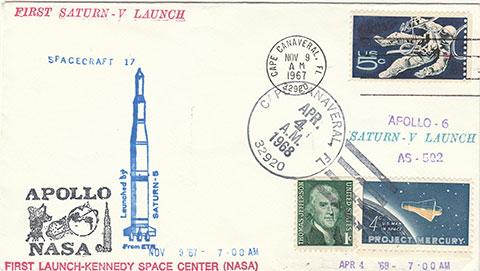|
|

|
|
Author
|
Topic: Space Cover 742: A Tale of two Saturn V's
|
Eddie Bizub
Member Posts: 145
From: Kissimmee, FL USA
Registered: Aug 2010
|
 posted 02-25-2024 08:19 AM
posted 02-25-2024 08:19 AM
   
Space Cover of the Week, Week 742 (February 25, 2024) Space Cover 742: A Tale of two Saturn V'sI'm sure we can all agree that the Saturn V was one of the most impressive launch vehicles to ever fly. It was 363 feet tall with a combined first stage thrust of 7.5 million pounds. With the detonation power of a small nuclear warhead it shook buildings at the press site 3 miles from the launch pad during launch. It was a purpose-built vehicle made to put the Apollo spacecraft into Earth orbit and then to reignite the third stage to send the command/service module and lunar module combination to the lunar environment. Without the Saturn V it is doubtful the US would have achieved the goal of landing men on the moon in 1969. There were a total of 13 Saturn V launches. The first two Saturn V launches were unmanned full-up test flights. These were known as Apollo 4 (AS-501) and Apollo 6 (AS-502). Apollo 4 was launched Nov. 9, 1967 and was a highly successful mission. Apollo 6 was launched April 4, 1968 and had a few issues with the second and third stages but was still considered a successful test flight. Once the Apollo 6 issues were understood and fixed, the next Saturn V launch sent the Apollo 8 crew into lunar orbit on Christmas Eve 1968. The above cover is postmarked for both test flights of the Saturn V launch vehicle. The cover is postmarked with a Cape Canaveral machine cancel for the Apollo 4 launch and has a Bob Whitney cachet commemorating the event. It was then postmarked with a Cape Canaveral hand cancel for the Apollo 6 launch. An impressive cover for an impressive launch vehicle. |
Axman
Member Posts: 410
From: Derbyshire UK
Registered: Mar 2023
|
 posted 02-25-2024 11:09 AM
posted 02-25-2024 11:09 AM
   
A very interesting cover. I was struck immediately by the blue text to the left of the Saturn V diagram — Spacecraft 17.I believe this designation might have one of two origins, or maybe a fortuitous combination of both! I wonder which one was foremost in the cachet maker's mind? It might mean that the Saturn V, propelling the Apollo 4 CSM, was 17th in the Apollo series, viz.: - SA-1 Saturn C-1 27Oct61
- SA-2 Saturn test, ice cloud 25Apr62
- SA-3 16Nov62
- SA-4 28Mar63
- SA-5 launch S-IV orbited
- Project Fire-1 14Apr64
- SA-6 (AS-101) boilerplate Apollo 28May64
- SA-7 (AS-102) 18Sep64
- SA-9 (AS-103) Pegasus 16Feb65
- Project Fire-2 22May65
- SA-8 (AS-104) Pegasus-B 25May65
- SA-10 (AS-105) Pegasus-3 30Jul65
- AS-201 1st Apollo u/manned 26Feb66
- AS-203 Saturn1b 5Jul66
- AS-202 2nd Apollo u/m flight 25Aug66
- Apollo 1 fire tragedy
- AS-501 Apollo 4 9Nov67
Or more probably that Command Module CM-017 flew, albeit with Service Module SM-020 after SM-017 was destroyed in a propellant tank explosion during ground testing.What do you think? |
Ken Havekotte
Member Posts: 3793
From: Merritt Island, Florida, Brevard
Registered: Mar 2001
|
 posted 02-25-2024 12:04 PM
posted 02-25-2024 12:04 PM
   
Yes, Alan, Spacecraft 17 (or 017) was the unmanned CSM number designation for AS-501, or better known as Apollo 4, the first Apollo/Saturn V flight vehicle. But that number label doesn't always mean that the spacecraft numbers always fall in order of each other. For instance the second Saturn V launch vehicle flew CSM-020 as AS-502/Apollo 6. Below are a couple more combo-covers regarding Apollo 4, but this time not with both Saturn V's together, but rather events that are 55 years apart; first flight covers of America's two largest but completely different launch vehicle programs launched from the same launch complex 39.  | |
Contact Us | The Source for Space History & Artifacts
Copyright 1999-2024 collectSPACE. All rights reserved.

Ultimate Bulletin Board 5.47a
|
|

|
 advertisement advertisement

|













